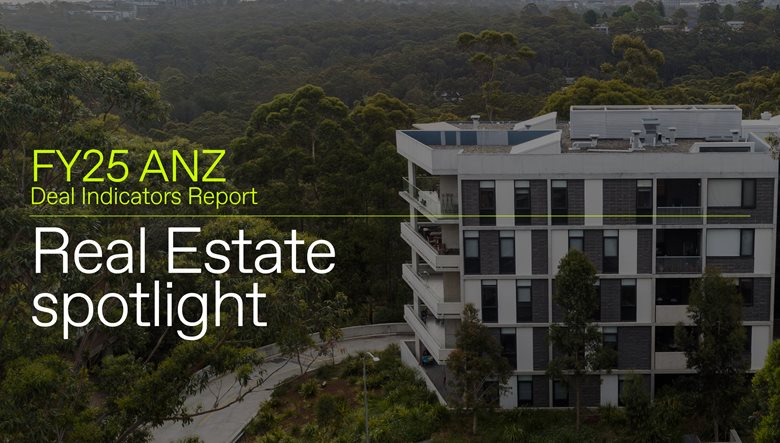Student beds and retirement villages: The real estate sectors driving deals in ANZ
The real estate sector in Australia and New Zealand has delivered markedly different M&A outcomes in FY25, with distinct patterns emerging on either side of the Tasman.
By AnsaradaTue Aug 19 2025Mergers and acquisitions, Industry news and trends, Innovation

According to our FY25 ANZ Deal Indicators Report, Australia's real estate M&A activity showed modest resilience, recording a 6% increase in year-over-year growth, despite a 10% decline in the June quarter. In contrast, New Zealand experienced volatility, with a 67% decline in quarterly activity, though the sector maintained stability over the 12-month period.
The Australian market's relative stability reflects sustained institutional interest and foreign capital inflows, while New Zealand's quarterly fluctuations suggest a more fragmented market responding to local economic pressures and regulatory changes.
Retirement living: The standout performer
Both markets witnessed substantial activity in retirement and aged care, though with different drivers and outcomes. Australia's retirement living sector benefited from strong demographic tailwinds, with the sector experiencing sustained demand for high-quality accommodation.
This was represented by Scape Operations and National Pension Service's $3.85 billion acquisition of Aveo Group from Brookfield Corp, representing one of Australia's largest direct real estate transactions in history.
New Zealand's retirement sector saw even more dramatic consolidation, with alternative infrastructure firm Stonepeak securing a definitive agreement to acquire Arvida Group, New Zealand's largest retirement and aged care provider. The all-cash transaction, valued at approximately $1.25 billion including debt assumption, offered investors $1.03 per share – representing a substantial 65% premium to Arvida's share price. This premium demonstrates the strong institutional appetite for quality retirement assets in New Zealand's developing market.
Student accommodation: Australia takes the lead
Australia dominated student accommodation investment during FY25, driven by international education recovery and infrastructure demands near leading universities. Greystar's $1.6 billion acquisition of a seven-asset, 5,662-bed purpose-built student accommodation portfolio across Sydney, Melbourne, Brisbane, Adelaide and Canberra marked a significant milestone for the global rental housing leader.
The portfolio's strategic positioning near leading Australian universities reflects the sector's focus on high-quality, well-located assets. Greystar's expansion plans include facility upgrades, branding refresh, and operational platform integration to enhance resident experiences – indicating confidence in Australia's long-term student accommodation fundamentals.
New Zealand's student accommodation sector remained relatively quiet during the period, suggesting different market dynamics and potentially limited institutional-grade stock available for acquisition.
Commercial real estate: Mixed signals and strategic positioning
Australia's commercial real estate sector presented mixed signals, with quality assets commanding premium pricing while secondary stock faced liquidity challenges. The division between institutional-grade assets and secondary stock remained pronounced, with investors concentrating capital into prime, well-located, income-resilient properties underpinned by strong tenant covenants.
Martin Stojkoski from ANZ’s Institutional Property Group said: “Sophisticated global investors, particularly from Europe, the US, and Asia have continued to engage with the Australian market, attracted by currency advantages, political stability, and pricing of high-quality assets.” This international interest supported competitive transaction processes for premium assets, with deep pools of global capital willing to pay through-cycle pricing.
Storage and specialised sectors also showed activity, with Abacus Storage King rejecting a $1.26 billion non-binding proposal from US-based Ki Corporation Limited and Public Storage. The rejection, based on the offer not reflecting fair value compared to recent independent valuations showing pro-forma net tangible assets of $1.73 per security, demonstrates disciplined vendor expectations in the current market.
Hotel investment: Recovery and repositioning
Both markets experienced hotel sector recovery, though Australia demonstrated stronger transactional momentum. Niall Kumar, Associate Director Hotels at Savills Australia said: “FY25 has marked a pivotal year for the hotel investment market across Australia and New Zealand.”
“Operationally, the sector has rebounded strongly, with RevPAR and occupancy levels returning to or exceeding pre-COVID benchmarks in several key markets. Sydney and Brisbane have led the recovery, with Hobart and Adelaide performing strongly as well.”
The investment landscape witnessed narrowing gaps between buyer and seller expectations, with sellers adopting more flexible deal structures including deferred payments and income guarantees to meet pricing expectations.
“There has also been a clear reactivation of private capital, particularly from Southeast Asian family offices, Australian syndicates, and New Zealand-based high-net-worth investors, who have stepped into a space previously dominated by institutional players,” adds Niall.
Looking forward: Structural changes and opportunities
FY26 presents transitional opportunities across both markets. Australian real estate fundamentals remain attractive to sophisticated global investors, with “increased appetite for value-add opportunities across logistics, life sciences, living sectors, and specialised real estate where operational income and structural demand underwrite medium to long-term value,” said Martin.
In Australia, the introduction of new merger laws, effective January 1 2026, will require dealmakers to build additional lead time into transactions and invest more heavily in early competition analysis. This regulatory evolution, combined with evolving international lending structures challenging traditional domestic banking conventions, will reshape how institutional capital flows operate.
For New Zealand, market stabilisation and modest growth projections from mid-2025 suggests improving fundamentals for real estate investment activity. Thomas Watson, Partner M&A Advisory at Deloitte NZ said: “Supported by our internal economic modelling, we believe the New Zealand economy has now stabilised and will experience modest growth from mid-2025. Regionally, Auckland, Waikato, and Christchurch are expected to exhibit strong growth, with population increases projected at 5-10% over the next five years.”
The real estate M&A market across Australia and New Zealand reflects broader economic realities while presenting sector-specific opportunities for discerning investors who can capitalise on regulatory shifts and demographic tailwinds.


